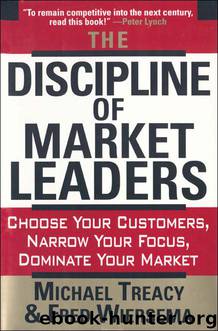The Discipline of Market Leaders: Choose Your Customers, Narrow Your Focus, Dominate Your Market by Michael Treacy & Fred Wiersema

Author:Michael Treacy & Fred Wiersema
Language: eng
Format: mobi, epub
ISBN: 9780465003976
Publisher: Basic Books
Published: 2007-03-19T14:00:00+00:00
What so distinguishes product leadership firms from most other companies today is that product leaders don’t slavishly follow the voice of the customer. The customer can’t define for them the next breakthrough product. Market researchers can’t define it, either. Although product leaders like Intel stay close to the market, they listen to the astute comments of customers only to hone their own judgment of the future. Customers can help them get the details right.
At Intel, the definition of the product is the first step in its development. The target may be far off, even far out, but engineers know where to direct their creative energies. That’s what we mean by thinking right to left—starting with a visionary concept crafted by leading thinkers and then instructing people to fire the arrows of their imagination straight to the target, not just anywhere into the future.
Gerry Parker: Since we are a product leader, we are always described in the press as being an innovator. That’s true, but innovation at Intel needs careful definition. When people talk about classic innovation, I always think of 3M. People at 3M are geared to invent one crazy thing after another. At Intel, the challenge is different. We also have a lot of bright people who want to innovate in totally new directions. But they often don’t understand that we have set a course that keeps us ahead of the market in computers and computer communications. We are essentially innovating to solve a very specific problem, not just any problem. We are not a think tank of innovation for its own sake. We are making a product.
To translate an idea into a product, you try to imagine the next logical step in the progression. What features does the market want and what can you put into your product? What will the technology allow you to do? By answering such questions, you basically define a product.
To make sure that manufacturing is preparing for the future, we look at the product and continually update it. We focus on what we think is going to happen. We are trying now to develop a model of what the future PC requires in total, what kind of components. The crucial element is trying to anticipate the demand five years out, both ours and for the rest of the PC market.
We need innovation, but a directed, disciplined innovation aimed at solving very specific problems. Even with the original microprocessor invention, Ted Hoff was trying to figure out a better way to make a calculator programmable. It was innovation to solve a specific problem we faced.
Albert Yu: One interesting process is trying to foresee what is going to be needed by the time we develop the successor to the Pentium processor. No one knows for sure, of course. We talk about those questions with a lot of software people, customers, end-users, and so forth. From that we have a pretty good idea of what the next chip should be like.
I should note that once we had completed the Pentium processor, we redefined who our customers are.
Download
The Discipline of Market Leaders: Choose Your Customers, Narrow Your Focus, Dominate Your Market by Michael Treacy & Fred Wiersema.epub
This site does not store any files on its server. We only index and link to content provided by other sites. Please contact the content providers to delete copyright contents if any and email us, we'll remove relevant links or contents immediately.
Hit Refresh by Satya Nadella(8854)
The Compound Effect by Darren Hardy(8508)
Change Your Questions, Change Your Life by Marilee Adams(7371)
Nudge - Improving Decisions about Health, Wealth, and Happiness by Thaler Sunstein(7240)
The Black Swan by Nassim Nicholas Taleb(6762)
Deep Work by Cal Newport(6562)
Daring Greatly by Brene Brown(6221)
Rich Dad Poor Dad by Robert T. Kiyosaki(6174)
Principles: Life and Work by Ray Dalio(5957)
Man-made Catastrophes and Risk Information Concealment by Dmitry Chernov & Didier Sornette(5645)
Playing to Win_ How Strategy Really Works by A.G. Lafley & Roger L. Martin(5492)
Digital Minimalism by Cal Newport;(5389)
Big Magic: Creative Living Beyond Fear by Elizabeth Gilbert(5351)
The Myth of the Strong Leader by Archie Brown(5237)
The Slight Edge by Jeff Olson(5199)
Discipline Equals Freedom by Jocko Willink(5156)
The Motivation Myth by Jeff Haden(5000)
Stone's Rules by Roger Stone(4853)
The Laws of Human Nature by Robert Greene(4770)
